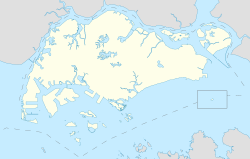| Al-Istiqamah Mosque | |
|---|---|
 The Al-Istiqamah Mosque in 2006 | |
| Religion | |
| Affiliation | Sunni Islam |
| Location | |
| Location | 2 Serangoon North Ave. 2, Singapore 555876 |
| Country | Singapore |
| Coordinates | 1°22′10″N103°52′32″E / 1.3693388°N 103.8755775°E |
| Architecture | |
| Style | Modern architecture with elements from Nusantara, Middle Eastern and Mauritian architecture |
| Completed | 1999 |
| Capacity | 3,300 |
The Al-Istiqamah Mosque (Malay : Masjid Al-Istiqamah), known locally as Masjid Al-Istiqamah, is a mosque in Serangoon, Singapore which was completed in 1999. It is located in the estate of Serangoon North, at the corner of Yio Chu Kang Road and Ang Mo Kio Avenue 3; the front entrance is located along Serangoon North Avenue 2. [1]









